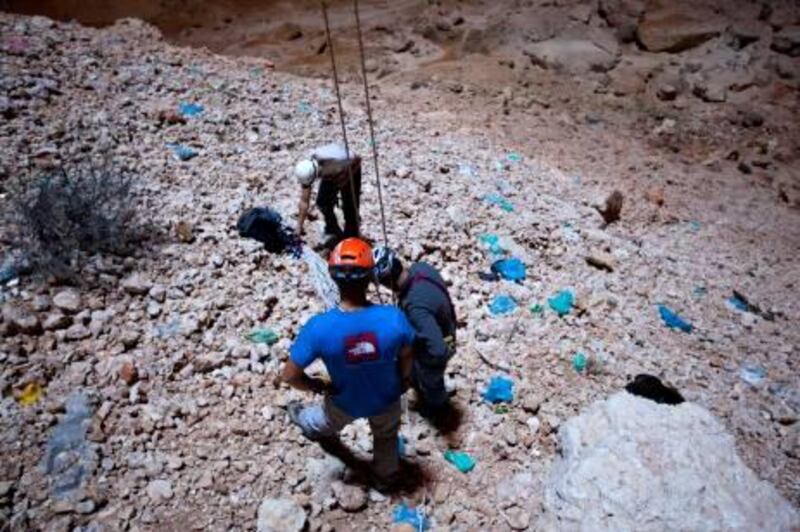SELMA PLATEAU, OMAN // Seventeen cavers have proven that taking out the rubbish need not be such a dull chore.
It took them a full day, but the cavers managed to haul 80 kilograms of rubbish out of Majlis Al Jinn, the ninth-largest chamber in the world.
Members of the Middle East Caving Expeditionary Team (Mecet) planned the expedition to remove rubbish - including the bones of hapless goats that had wandered too close to the edge - which had accumulated over the years from the Omani cave.
Omani officials rarely give permission to abseil into Majlis Al Jinn, but the specialist team from Dubai, who usually explore other networks in the area, were invited by the government to clean the cave on the Selma Plateau, about three hours' drive south of Muscat.
The team of expatriates abseiled 158 metres through Cheryl's Drop last month, a two-metre wide crack in the side of a mountain. There was a drop of about 20 metres before the chamber opened.
On return, some of the cavers climbed out using jumar clamps, while others were winched up the first drop hole along with the rubbish.
Pete Pergande, a pilot for Emirates Airline who has rappelled down towers in Utah but had not before attempted such a confined space, said that on the 20-minute abseil down he had to remind himself to take in the view.
Mr Pergande, 31, said he normally checked everything three or four times.
"I think about the gear a lot. I double, triple-check everything before I put all my weight on the gear," he said. "I'm very cautious of that and once I am happy with the set-up, it's a pretty exciting moment."
Once on the ground, Mr Pergande and the team started to pick up plastic bottles and bags.
"We were picking up a lot of light stuff like plastic bags," he said. "There wasn't stuff like tyres, or stuff people blatantly threw in there. There was a fair share of broken bottles and waste that was blown in."
Will Hardie, 35, said the expedition was not like the usual trips the team took.
"There was a bit of a novelty with this mission because it had a purpose, to clean up and bring [the rubbish] out gave it some extra meaning," Mr Hardie said. "It wasn't just a pleasure trip."
The cave was first explored and surveyed in 1985. It is so large that one of the Pyramids of Giza would easily fit inside.
Light beams shine through three holes, and at certain times of the day a beam will shine across the chamber.
Gavin Cassidy, a broadcasting bid manager from Northern Ireland, said this drop was different.
"The whole point of this cave was the sheer height and the vast space of it," said Mr Cassidy, 31.
On his first cave drop, he said, he focused only on the ropes and did not take in the atmosphere.
"On this, I wanted to open my mind and take it in, and see how huge this was and how small people were below," Mr Cassidy said.
The team spent considerable time planning the trip before the eight-hour drive from Dubai to the campsite nearby the cave.
"It was quite challenging," said Mr Hardie, group managing director of Pinnacle PR. "First we had to figure out how to get it out, toughen up the way it was wrapped and sealed, try to haul the bags past the rocky bits so they wouldn't rip open and fall back down."
They took down two large tarpaulins and decided to lift most of the rubbish on its own.
"The main challenge was getting it over the top," Mr Hardie said.
The rubbish was pulled by a winch, which the operators had to connect so that it would not get tangled on the cliff lip and tear the bags or damage the equipment, endangering those still below.
Mr Hardie was the last man to leave the cave. He wrapped three sheets of corrugated iron in the tarp and attached it to the end of his rope before he was winched out.
"That was tricky to load because it was sharp and the edges were like blades, and we couldn't have that going anywhere near a rope," he said. "I had to make sure it didn't cut the rope or bang off the edges. I didn't want to be left down there with no ropes."
Omanis gathered around the hole to watch the spectacle.
"The local guys were amazed to see everything coming out," Mr Hardie said.
"We were wondering how we'd get it back down the mountain but all that metal disappeared once it got back on top."
It was Mecet's fourth trip to the plateau and the group has another planned for next month.
"There are no restrictions on the other caves so this was not the normal type of caving for adventure and fun," Mr Hardie said.





